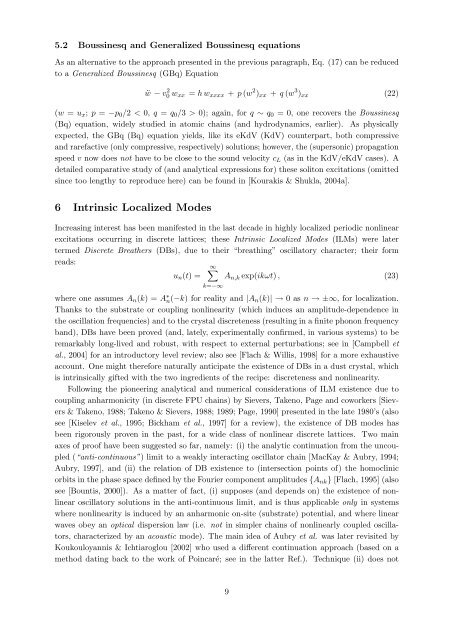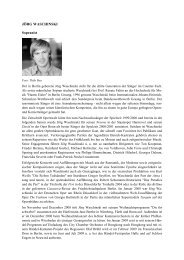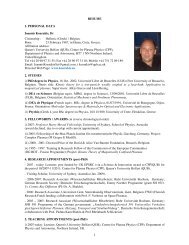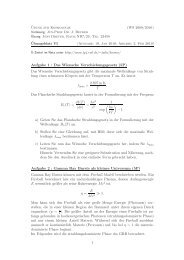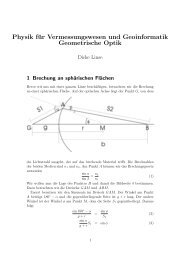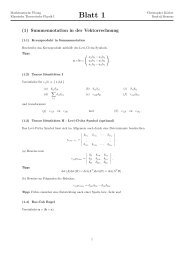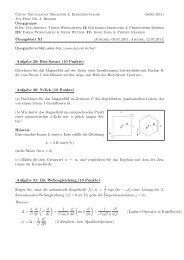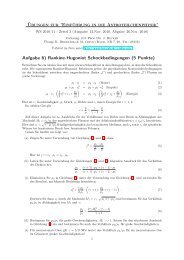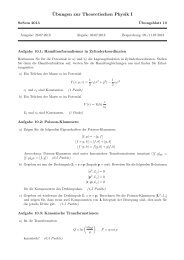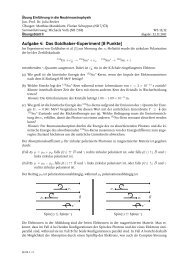View - Theoretische Physik IV - Ruhr-Universität Bochum
View - Theoretische Physik IV - Ruhr-Universität Bochum
View - Theoretische Physik IV - Ruhr-Universität Bochum
Create successful ePaper yourself
Turn your PDF publications into a flip-book with our unique Google optimized e-Paper software.
5.2 Boussinesq and Generalized Boussinesq equations<br />
As an alternative to the approach presented in the previous paragraph, Eq. (17) can be reduced<br />
to a Generalized Boussinesq (GBq) Equation<br />
ẅ − v 2 0 w xx = hw xxxx + p (w 2 ) xx + q (w 3 ) xx (22)<br />
(w = u x ; p = −p 0 /2 < 0, q = q 0 /3 > 0); again, for q ∼ q 0 = 0, one recovers the Boussinesq<br />
(Bq) equation, widely studied in atomic chains (and hydrodynamics, earlier). As physically<br />
expected, the GBq (Bq) equation yields, like its eKdV (KdV) counterpart, both compressive<br />
and rarefactive (only compressive, respectively) solutions; however, the (supersonic) propagation<br />
speed v now does not have to be close to the sound velocity c L (as in the KdV/eKdV cases). A<br />
detailed comparative study of (and analytical expressions for) these soliton excitations (omitted<br />
since too lengthy to reproduce here) can be found in [Kourakis & Shukla, 2004a].<br />
6 Intrinsic Localized Modes<br />
Increasing interest has been manifested in the last decade in highly localized periodic nonlinear<br />
excitations occurring in discrete lattices; these Intrinsic Localized Modes (ILMs) were later<br />
termed Discrete Breathers (DBs), due to their “breathing” oscillatory character; their form<br />
reads:<br />
∞∑<br />
u n (t) = A n,k exp(ikωt), (23)<br />
k=−∞<br />
where one assumes A n (k) = A ∗ n(−k) for reality and |A n (k)| → 0 as n → ±∞, for localization.<br />
Thanks to the substrate or coupling nonlinearity (which induces an amplitude-dependence in<br />
the oscillation frequencies) and to the crystal discreteness (resulting in a finite phonon frequency<br />
band), DBs have been proved (and, lately, experimentally confirmed, in various systems) to be<br />
remarkably long-lived and robust, with respect to external perturbations; see in [Campbell et<br />
al., 2004] for an introductory level review; also see [Flach & Willis, 1998] for a more exhaustive<br />
account. One might therefore naturally anticipate the existence of DBs in a dust crystal, which<br />
is intrinsically gifted with the two ingredients of the recipe: discreteness and nonlinearity.<br />
Following the pioneering analytical and numerical considerations of ILM existence due to<br />
coupling anharmonicity (in discrete FPU chains) by Sievers, Takeno, Page and coworkers [Sievers<br />
& Takeno, 1988; Takeno & Sievers, 1988; 1989; Page, 1990] presented in the late 1980’s (also<br />
see [Kiselev et al., 1995; Bickham et al., 1997] for a review), the existence of DB modes has<br />
been rigorously proven in the past, for a wide class of nonlinear discrete lattices. Two main<br />
axes of proof have been suggested so far, namely: (i) the analytic continuation from the uncoupled<br />
(“anti-continuous”) limit to a weakly interacting oscillator chain [MacKay & Aubry, 1994;<br />
Aubry, 1997], and (ii) the relation of DB existence to (intersection points of) the homoclinic<br />
orbits in the phase space defined by the Fourier component amplitudes {A nk } [Flach, 1995] (also<br />
see [Bountis, 2000]). As a matter of fact, (i) supposes (and depends on) the existence of nonlinear<br />
oscillatory solutions in the anti-continuous limit, and is thus applicable only in systems<br />
where nonlinearity is induced by an anharmonic on-site (substrate) potential, and where linear<br />
waves obey an optical dispersion law (i.e. not in simpler chains of nonlinearly coupled oscillators,<br />
characterized by an acoustic mode). The main idea of Aubry et al. was later revisited by<br />
Koukouloyannis & Ichtiaroglou [2002] who used a different continuation approach (based on a<br />
method dating back to the work of Poincaré; see in the latter Ref.). Technique (ii) does not<br />
9


